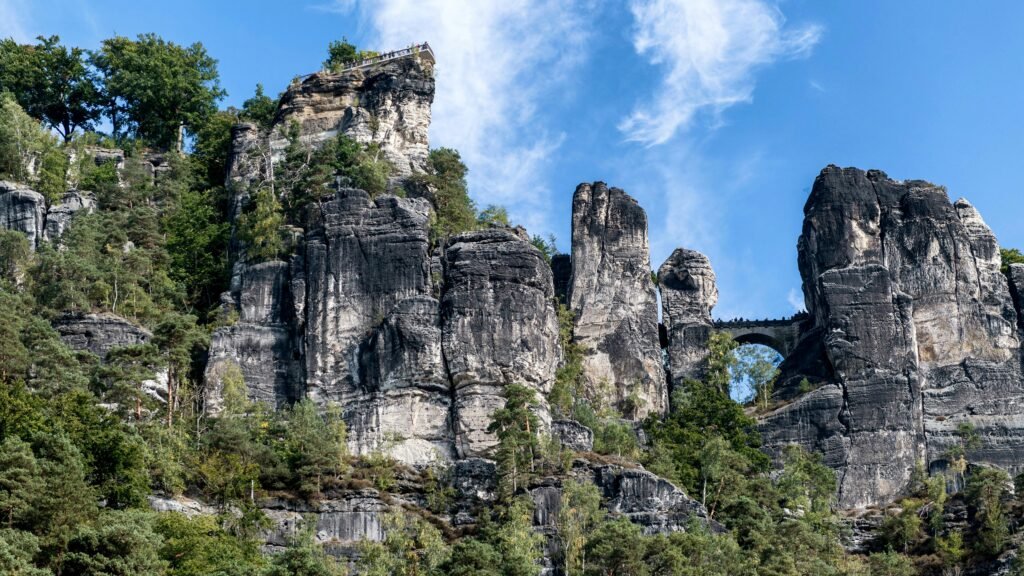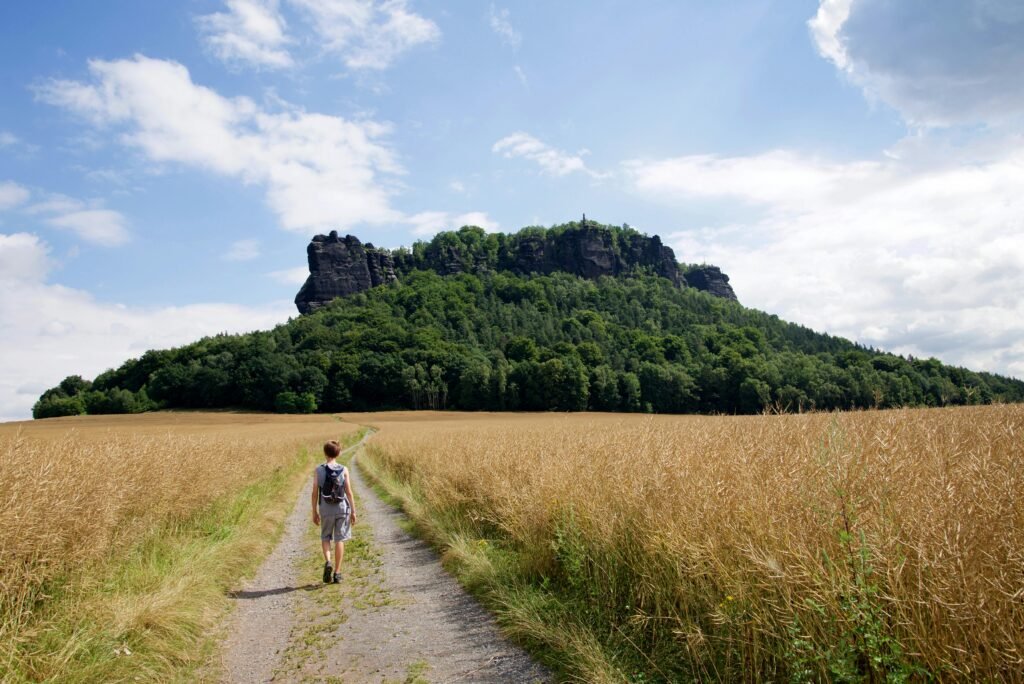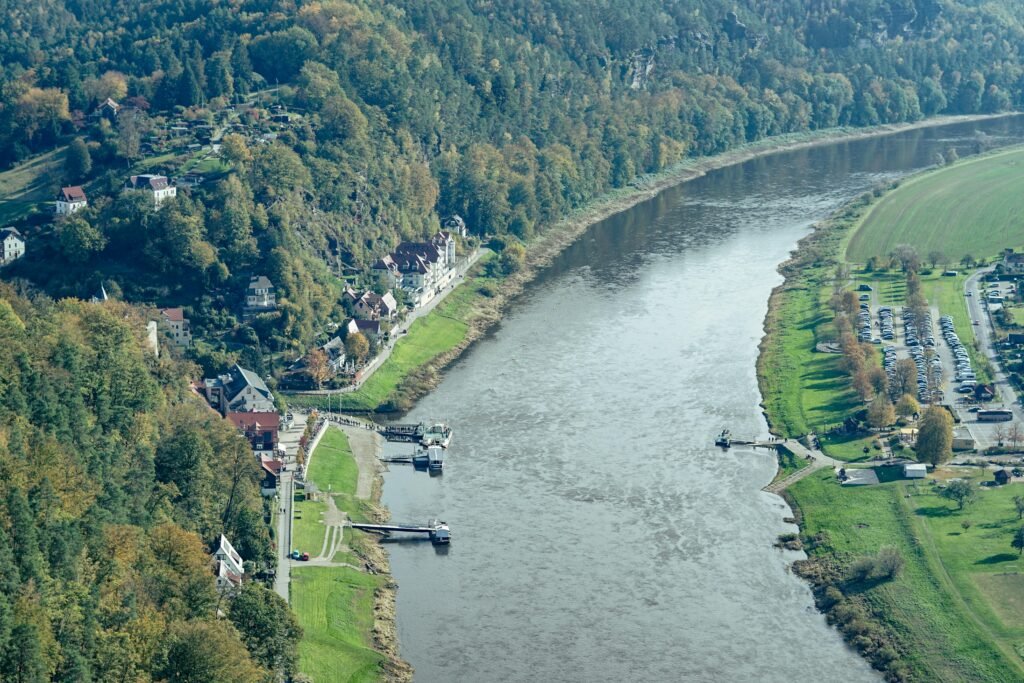Introduction to Sächsische Schweiz
Sächsische Schweiz, or Saxon Switzerland, is a breathtaking natural region located in eastern Germany, renowned for its remarkable sandstone rock formations, lush valleys, and striking cliffs. This stunning landscape, situated primarily within the confines of the Saxon Switzerland National Park, spans the borders with the Czech Republic, offering a unique blend of geological, ecological, and cultural wonders. The area is characterized by its distinctive Bastei rock formation, which rises majestically above the Elbe River and offers panoramic views of the surrounding terrain.

Visitors to Sächsische Schweiz are often captivated by the dramatic topography and diverse ecosystems that this region has to offer. The sandstone cliffs, sculpted by centuries of natural erosion, present both aesthetic beauty and opportunities for adventurous pursuits, drawing rock climbers, hikers, and nature enthusiasts from around the globe. The well-maintained network of hiking trails connects various points of interest, allowing for an immersive experience in the heart of this captivating landscape. As a testament to its natural grandeur, the Sächsische Schweiz region has inspired artists and poets alike, contributing significantly to the cultural heritage of Germany.
In addition to its natural splendor, Sächsische Schweiz is imbued with historical significance, with charming villages and quaint towns dotting the landscape. These settlements not only provide a glimpse into the region’s rich history but also serve as gateways for exploration. The local gastronomy reflects traditional Saxon cuisine, with an emphasis on locally sourced ingredients that enhance the overall experience of visiting this remarkable area. Beyond the scenic beauty, Sächsische Schweiz is an exceptional destination that combines outdoor adventure with cultural exploration, making it a must-visit location for those seeking to connect with nature and history.
Unique Sandstone Formations
Sächsische Schweiz, renowned for its dramatic landscapes, boasts an array of unique sandstone formations that play a pivotal role in the region’s geological framework. The landscape, predominantly shaped by sandstone, emerged as a result of intricate natural processes that have unfolded over millions of years. The formation of these sandstone structures originated during the Triassic period, approximately 200 to 250 million years ago, when vast deserts covered the region. Sand was deposited in layers, compacting over time to create the solid rock we see today.
The distinctive formations can be attributed to a combination of erosion and weathering, sculpting the original sandstone into striking cliffs, towers, and gorges. Water, combined with natural elements, has carved intricate shapes and deep valleys, creating a picturesque scenery that draws visitors and geologists alike. These geological phenomena, such as the iconic Bastei Bridge and the elusively shaped Pfaffenstein peak, illustrate the beauty forged by nature’s relentless forces.
The importance of these sandstone formations extends beyond their aesthetic appeal. They serve as vital habitats for a diverse range of flora and fauna, many of which thrive in the unique microclimates created by the rock structures. Additionally, the geological significance of these formations offers invaluable insights into the Earth’s historical climate and environmental shifts. As a result, the preservation of Sächsische Schweiz’s unique sandstone formations is crucial, both for ecological balance and for advancing our understanding of geological processes.
In conclusion, the unique sandstone formations of Saxon Switzerland stand as a testament to the planet’s intricate geological history. Their distinct characteristics and ecological importance heighten the allure of Sächsische Schweiz, making it a must-visit destination for nature lovers and geological enthusiasts alike.

Must-See Destinations in Saxon Switzerland
Saxon Switzerland, renowned for its stunning landscapes and geological wonders, offers a plethora of attractions that captivate visitors. One of the most iconic structures in this region is the Bastei Bridge, which soars above the picturesque Elbe River. This breathtaking sandstone archway provides panoramic views of the surrounding valleys and is a popular viewpoint for photographers and nature enthusiasts alike. The bridge, built in the mid-19th century, connects formations that have stood the test of time, inviting exploration of the rugged trails that wind through the area.
Another remarkable destination is the Königstein Fortress, a historic stronghold that has protected the region for centuries. Perched atop a rocky plateau, this fortress not only boasts impressive architecture but also offers a rich tapestry of history. Visitors can explore its museums, wander through its expansive grounds, and learn about its strategic importance through various exhibits. The fortress holds the distinction of being one of the largest mountain forts in Europe, making it a significant site of interest for those keen on military history and architecture.
Additionally, the Elbe Sandstone Mountains provide a natural backdrop that is equally captivating. This unique formation is characterized by towering sandstone cliffs, deep gorges, and lush forests, making it ideal for hiking and outdoor activities. Encompassed within the Saxon Switzerland National Park, these mountains are home to numerous trails that cater to a range of skill levels. As visitors traverse the landscapes, they encounter diverse flora and fauna, creating an immersive experience in the great outdoors.
With its rich historical landmarks and breathtaking natural beauty, Saxon Switzerland captivates all who venture into its depths, making each destination a must-see on any travel itinerary.
Outdoor Activities: Hiking and Rock Climbing
Sächsische Schweiz, or Saxon Switzerland, is renowned for its breathtaking landscapes, offering a plethora of outdoor activities for nature enthusiasts. Among the most popular are hiking and rock climbing, which attract adventurers of all skill levels. The region is adorned with a myriad of marked trails that cater to various abilities, ensuring that both seasoned hikers and beginners can immerse themselves in the natural beauty that surrounds them.
One notable trail is the Malerweg, a picturesque route stretching approximately 112 kilometers. This trail meanders through diverse terrains, including dense forests, rocky cliffs, and serene meadows, allowing hikers to witness the stunning rock formations that Saxon Switzerland is famous for. The Malerweg is divided into stages, making it easy for individuals to tailor their hiking experience according to their fitness levels and available time. Along the way, visitors can find ample resting spots and observation points perfect for appreciating the scenic vistas.
Rock climbing is another significant draw in Saxon Switzerland, with its sandstone cliffs offering an array of routes for climbers. The region is recognized for its unique climbing traditions, including the use of traditional protection methods instead of bolts, which emphasizes a more natural approach to the sport. Climbers can challenge themselves on various crags, such as the renowned Bastei and the impressive Affensteine. Local climbing schools and guides provide instruction and support, ensuring that novices can embark on their climbing journey safely.
In addition to hiking and climbing, the region features options such as guided nature excursions, which further enhance visitors’ experience of Saxon Switzerland’s stunning flora and fauna. Whether engaging in a leisurely hike or testing one’s limits on a climbing face, outdoor activities in Saxon Switzerland provide an unparalleled opportunity to connect with nature.

Exploring Charming Villages
The Sächsische Schweiz, or Saxon Switzerland, is well-known for its stunning landscapes and dramatic rock formations; however, the enchanting villages nestled within and around this national park also deserve recognition. These communities not only enhance the visual appeal of the region but also embody the rich cultural heritage and traditions that define the local lifestyle. Each village has its own distinct character, offering visitors a unique glimpse into the history and customs of the area.
One notable village is Pfaffendorf, which captivates with its charming half-timbered houses and serene atmosphere. This quaint settlement is an ideal starting point for exploring nearby hiking trails while providing access to breathtaking views of the Elbe River. Additionally, the village hosts local markets where visitors can experience regional delicacies and handcrafted goods, solidifying its cultural significance.
Further along, the village of Rathen lies at the foot of the iconic Bastei rock formation. Known for its picturesque setting, Rathen offers visitors opportunities to engage in various outdoor activities, such as rock climbing and hiking. The presence of historic architecture, including the beautiful St. Johannis Church, contributes to the charm of this village. The annual events held in Rathen, like the traditional Christmas market, attract both locals and tourists, celebrating the rich heritage of the region.
Conversely, the village of Königstein showcases both historical and natural attractions. The Königstein Fortress, one of the largest hilltop castles in Europe, is an emblem of the area’s storied past. From this vantage point, visitors can appreciate the stunning panorama of Saxon Switzerland, making it a must-visit location. The blend of cultural experiences and spectacular scenery in these villages creates a compelling travel itinerary for anyone seeking to explore the lush beauty of Saxon Switzerland.
Visiting Saxon Switzerland National Park
Saxon Switzerland National Park, a treasure of natural beauty nestled in the heart of the Saxon Switzerland region, offers an exhilarating experience for hikers and climbers alike. To make the most of your visit, it is essential to be well-prepared. The park boasts a variety of pathways, with trails catering to different skill levels. The popular Bastei trail, for instance, provides stunning views of the iconic rock formations and the Elbe River, while more challenging routes, such as the Schrammsteine, appeal to seasoned adventurers seeking a thrill.
When planning your journey, wear appropriate footwear; sturdy hiking boots are critical for navigating the rugged terrain. Additionally, layering your clothing is advisable since weather conditions can change rapidly in the park. Bringing along essentials such as a first-aid kit, snacks, and sufficient water ensures a comfortable experience. For climbers, ensuring you have the necessary gear, including harnesses, ropes, and a helmet, is paramount to ensure safety during your adventures.
Familiarizing yourself with safety guidelines is also essential. The park encourages responsible hiking, urging visitors to stay on marked trails to protect delicate ecosystems. Always inform someone about your plans and expected return time, especially if you are venturing into more remote areas. Climbing in specific locations may require obtaining a permit, and understanding park regulations regarding rock climbing is vital to avoid any legal issues while ensuring the conservation of these spectacular structures.
Conservation efforts are a priority at Saxon Switzerland National Park. As a visitor, it is your responsibility to respect wildlife and habitats by adhering to local guidelines, such as not littering and keeping a safe distance from animals. By following these tips, you can contribute to the preservation of this stunning park while enjoying its natural wonders.
Cultural Attractions Nearby
While Sächsische Schweiz is renowned for its stunning natural landscapes, the region is equally rich in cultural attractions that offer insight into its historical and artistic heritage. A prominent cultural site is the Bastei, a dramatic sandstone rock formation that features the iconic Bastei Bridge, along with a museum that explores the geography, flora, and fauna of the area. This picturesque location draws not only nature enthusiasts but also history buffs eager to learn about the cultural significance of the Bastei throughout different periods.
Another standout attraction is the Königstein Fortress, which towers over the Elbe River. This impressive fortification dates back to the early 13th century and serves as a testament to the region’s military history. Visitors can explore various exhibits that showcase the fortress’s storied past, including its role as a royal residence and a military stronghold. The stunning views from the fortress provide a striking contrast to the surrounding peaks of saxon Switzerland, allowing for a unique perspective on the natural beauty of the area.
In addition to these historical landmarks, the nearby town of Pirna is worth a visit for its well-preserved old town and cultural events. This charming town frequently hosts art exhibitions, music festivals, and local markets that showcase the vibrant community spirit and artistry of the region. Furthermore, the Carola Bridge in Pirna offers a direct transition from the urban environment to the stunning nature of Sächsische Schweiz. It is recommended for visitors to attend one of the various local events to fully immerse themselves in the culture and hospitality of this scenic area.
Overall, the combination of impressive castles, museums, and lively local events makes the cultural attractions surrounding Sächsische Schweiz an essential part of any visitor’s experience. The rich history and artistic pursuits encountered in this region effectively complement the breathtaking natural scenery, providing a holistic exploration of both nature and culture.
Best Seasons for Outdoor Exploration
When planning a visit to Saxon Switzerland, understanding the best seasons for outdoor exploration can significantly enhance one’s experience. This stunning national park, known for its dramatic sandstone formations and lush greenery, offers a variety of activities that can vary greatly depending on the season. Typically, the most favorable times for outdoor activities are spring and autumn, due to the mild weather and breathtaking scenery.
Spring, particularly from April to June, is a wonderful time to explore the region. As the landscape awakens from winter, wildflowers bloom, and trees begin to regain their vibrant colors. Visitors can enjoy hiking trails that are adorned with blossoming flora, making outdoor exploration a delightful sensory experience. The temperatures during this season are generally mild, averaging between 10°C and 20°C, making it comfortable for activities such as hiking, climbing, and photography. Additionally, local events, such as flower festivals, can be found during this time, further enriching the visitor experience.
Autumn, from September to November, is equally captivating. The fall foliage transforms the valleys and cliffs into a kaleidoscope of colors, offering stunning views ideal for activities like hiking and scenic photography. The cooler temperatures, generally ranging from 5°C to 15°C, enable comfortable exploration without the summer crowds. Visitors during this season can also partake in harvest festivals, which provide an authentic taste of local culture and cuisine.
While summer, particularly July and August, does attract many tourists and offers warmer temperatures suitable for swimming and longer hikes, the increased foot traffic can sometimes detract from the serenity of nature. Winter months may also be appealing for those interested in winter sports, although conditions can be harsher, and many trails may be less accessible.
Practical Tips for an Unforgettable Visit
When planning your trip to Sächsische Schweiz (Saxon Switzerland), it is crucial to consider various practical aspects to ensure an enjoyable experience. First, transportation options are plentiful, making it accessible for travelers from nearby cities and regions. The closest major city, Dresden, offers efficient rail connections to the region, with regular trains that can take you to key locations such as Bad Schandau and Pirna. Additionally, buses operate frequently in the area, allowing visitors to navigate between the numerous hiking trails and natural marvels found throughout the national park.
Accommodation choices in Saxon Switzerland range from quaint guesthouses to well-equipped hotels, catering to diverse preferences and budgets. For those who favor a closer connection to nature, camping facilities are available in designated areas, providing a unique opportunity to immerse oneself in the stunning landscapes. It is advisable to book accommodations in advance, particularly during peak travel seasons, ensuring you secure your preferred lodging and avoid last-minute surprises.
While visiting this picturesque region, sampling local cuisine is highly recommended. Restaurants and eateries offer a variety of dishes that highlight regional flavors, including hearty fare such as regional sausages, wild game, and fresh river fish. Don’t miss the opportunity to try locally produced wines and craft beers that complement the dining experience perfectly. Engaging with local food culture not only delights the palate but also enriches the overall visit, creating lasting memories of the time spent in Saxon Switzerland.
Ultimately, by considering transportation, accommodation, and local cuisine, travelers can effectively plan their itinerary, leading to an unforgettable exploration of the natural marvels in Sächsische Schweiz.



